When MSC Cruises first showed the world a sneak peek at how new ship MSC World America would look, it was clear that the line had borrowed a few tricks from the playbooks of other cruise lines – largely Royal Caribbean.
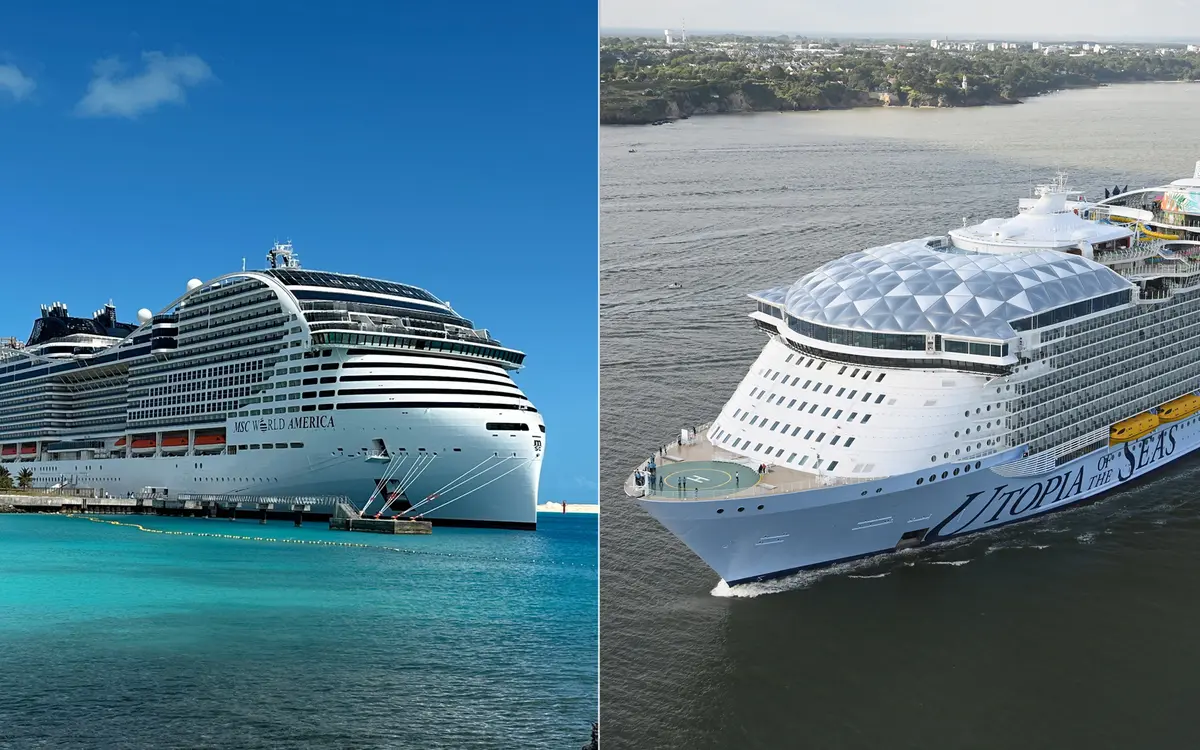
The most obvious similarity is the ship’s “district” concept. In 2009, with the debut of Oasis of the Seas, Royal Caribbean introduced “neighborhoods,” which grouped similar amenities together, making it easier for cruisers to find the areas that appeal to them. It also helps with passenger flow.
Although MSC isn’t the first cruise line to co-opt the idea from Royal Caribbean – Carnival Cruise Line also adopted it for its Excel Class ships in the form of “zones” – it is the first one to borrow not only the grouping premise but also the physical layout of several spaces.
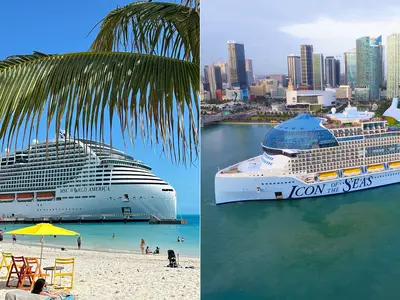
With its partially enclosed outer deck, punctuated by a heart-pounding dry slide and straddled by inward-facing balcony cabins, and its interior social hub of stores, bars and restaurants, MSC World America evokes Royal Caribbean’s Icon and Oasis Class vessels in many ways. But that doesn’t mean it hasn’t added some touches of its own.
Here, we’ll look at how the 6,764-passenger vessel compares to both Icon Class and Oasis Class ships and ways in which it might have actually done things better (or worse) than the competition.
Atrium areas

The Galleria, MSC World America’s indoor promenade area, feels like a shopping mall. Its mix of stores, bars, restaurants, and entertainment venues is reminiscent of the Royal Promenade on many Royal Caribbean vessels. (Although the Royal Promenade was first introduced on Voyager of the Seas in 1999, it was such a hit that Royal Caribbean made it one of the key Oasis Class neighborhoods and then carried if over to Icon Class ships.)
For its version, MSC has added arcade-style gaming, a complimentary burger and pizza joint, and a third deck, allowing the space to encompass much of the ship’s added-fee specialty dining – something that also makes it similar to Norwegian Cruise Line’s 678 Ocean Place social hub. It has also carried over the LED ceiling from its Meraviglia Class ships, showing fun scenes like SCUBA divers swimming around overhead.
Like Royal Caribbean, MSC has positioned its guest services, shore excursion and future cruise desks in this area.
What’s most notably different, though, is that MSC’s version of the highly trafficked thoroughfare feels less crowded. There are no jewelry counters or standalone Starbucks kiosks to clog up the works as cruisers pass through. Also absent in MSC’s take are a classic car and the Rising Tide Bar – both hallmarks of the Royal Promenade.
Additionally, the two upper decks of The Galleria offer full walk-around access for passengers – something that makes it more similar to the Royal Promenade on Icon Class ships than on Oasis Class ones. There are no dead ends that force them to double back in order to move from deck to deck, which is often an issue in the Royal Promenade on some of Royal Caribbean’s ships. Despite the somewhat cumbersome positioning of the beautiful chrome staircases that zig-zag between all three decks of The Galleria, the setup still affords decent passenger flow.
Outdoor areas
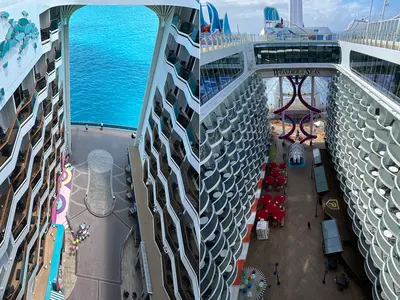
MSC World America’s largely outdoor promenade area, known as The Promenade (not to be confused with the indoor Royal Promenade on Royal Caribbean ships), is the most obvious example of MSC’s “borrowing” of ideas. Not only is the space almost structurally identical to Royal Caribbean’s Boardwalk neighborhood, but it also offers similar amenities.
The biggest copycat offerings include the district’s inward-facing balconies; a single 11-deck Jaw Drop dry slide, mimicking Royal Caribbean’s dual 10-deck Ultimate Abyss dry slides; All-Star Sports Bar, which is similar to Royal Caribbean’s Playmakers; and a burger and hot dog outpost that combines elements of Royal’s Boardwalk Dog House and Johnny Rockets, which has locations on several Royal Caribbean vessels.
World America’s Promenade also houses Sweet Temptations – like Royal Caribbean’s Sugar Beach, on steroids. It sells small toys and stuffed animals, as well as candy, ice cream, waffles, milkshakes and crepes that can be adorned with a variety of colored and flavored frostings and toppings. The layout is magical, too, making you feel like you’ve stepped into the Candy Land board game.
Much like The Galleria has eliminated many of the passenger flow problems the Royal Promenade has, The Promenade has removed walkway obstacles you’d expect to find on The Boardwalk. There’s no carousel or aft-facing AquaTheater. That makes the area feel less congested, and passengers can enjoy unobstructed views of World America’s wake.
Two other big tweaks MSC has made to this district are the addition of the Coffee Emporium – a lovely cafe that offers sweet treats, sandwiches and for-fee specialty coffee beverages – and Paxos, a Greek taverna specialty restaurant.
Family areas
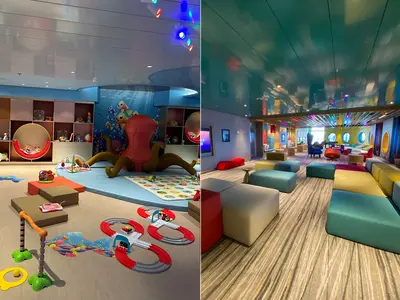
Family areas are another realm where MSC has challenged Royal Caribbean head-on. Combined, MSC World America’s Family Aventura and Aqua Deck districts comprise similar indoor and outdoor spaces and activities to what would result if you combined Royal Caribbean’s Youth Zone and Pool and Sports Zone neighborhoods. Within these sections, passengers can seek out thrill rides, video games and watery fun.
MSC offers five different clubs under its Doremiland youth programming umbrella; similarly, Royal Caribbean’s Adventure Ocean is parsed into five groups. Both lines divide children by age and cater to kids from 6 months to 17 years.
MSC leverages its partnership with LEGO to offer a building-block wonderland for kids of all ages – Duplo for the littlest cruisers and standard bricks for older kids. MSC has also added a theater-style room (similar to Royal Caribbean’s Adventure Ocean Theater) for Doremiland participants, allowing for performances and movie viewing.
One major difference here, which complicates things further, is that Royal Caribbean has replaced the Boardwalk Neighborhood on its Icon Class ships with Surfside, which hosts most of the vessels’ family-friendly activities, splash areas and kids clubs.
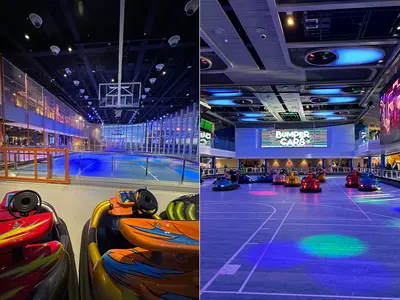
On MSC World America, Doremiland is part of the Family Aventura district, which also includes a gaming arcade and MSC Sportplex (nearly identical to Royal Caribbean’s Quantum Class SeaPlex sports and gaming area, right down to the bumper cars), outdoor thrill rides (Cliffhanger mechanical swings and a ropes course on MSC and FlowRider surf simulators and rock climbing walls on Royal Caribbean), entry to the ship’s Jaw Drop dry slide (a knock-off of Royal Caribbean’s Ultimate Abyss) and The Harbor waterslides and kiddie splash zones (rivaling Royal Caribbean’s Perfect Storm waterslides and Splashaway Bay splash area).
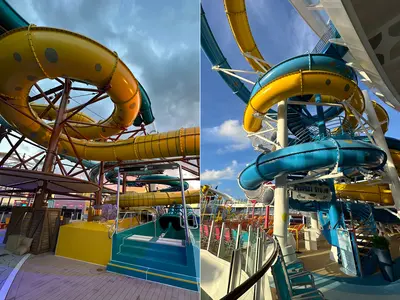
World America’s Aqua Deck district wraps up two distinct all-ages pool areas: the outdoor Mar Azul, which is great for sunbathers, and the indoor Botanic Garden Pool, which is enclosed and features a cool, leafy theme. Both have their own bars and hot tubs.
This setup differs substantially from Royal Caribbean’s Oasis Class Pool and Sports Deck neighborhood in a couple of key ways. First, in its pool neighborhood, Oasis Class ships incorporate a lot of the sports and thrill experiences that MSC has, instead, rolled into its Family Aventura district.
Additionally, Royal Caribbean’s Pool and Sports Deck section features four themed, clustered outdoor pools (the standard Main Pool, a graded-entry Beach Pool, the H2O Zone Pool for families and the Sports Pool, which hosts activities like lap swimming and badminton) and a separate enclosed Solarium pool that’s just for adults. (MSC World America offers two adults-only pools, but they’re part of its Zen Area district, which is separate from the Aqua Deck pool district.)

World America’s layout is more closely related to that of Royal Caribbean’s Icon Class vessels – Icon of the Seas and soon-to-debut Star of the Seas – which feature neighborhoods different from those found on Oasis Class ships.
Like MSC World America’s Aqua Deck, Icon of the Seas’ Chill Island encompasses two pools – Bay Pool, the largest pool on a cruise ship, and the Cloud 17 infinity pool. Additionally, the Thrill Island neighborhood aligns closely with World America’s Family Aventura district in that it features waterslides and a ropes course.
Suites
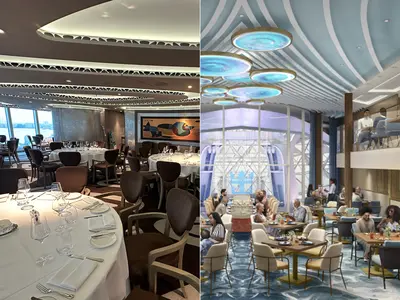
Although Royal Caribbean has historically led the way in terms of cruise ship innovations, suite enclaves are one area where MSC was faster to the market. Norwegian Cruise Line introduced the concept of a dedicated suite area in 2005, and MSC followed suit in 2008.
However, Royal Caribbean didn’t focus heavily on high-end accommodations until it rolled out the Royal Suite Class in 2016. Even so, not all ships that offer Royal Suite Class amenities have private, exclusive areas. With the debut of Oasis Class ship Wonder of the Seas in 2022, a Suite Neighborhood was officially added to the fleet and has since appeared on other ships in the Oasis and Icon Classes.
MSC’s version, the MSC Yacht Club, which is one of the seven districts on World America, offers swankier versions of all cabin types, ranging from insides to spacious suites with multiple rooms. Meanwhile, Royal Caribbean’s Suite Neighborhood is made up of only true suites – cabins (not including insides) with more space and luxury touches.
Cabins in both the MSC Yacht Club and the Suite Neighborhood are grouped in a private keycard-accessed area that offers passengers exclusive dining, drinks, a lounge, a sun deck and the services of a butler and concierge. Also included are perks like free Wi-Fi, priority embarkation and disembarkation, and exclusive beach access in the lines’ private destinations of Ocean Cay (MSC) and Labadee (Royal Caribbean).
Other similarities

The most in-your-face similarities between MSC World America and Royal Caribbean’s Icon and Oasis Class ships lie in the vessels’ themed districts and zones, but they aren’t the only places with similar concepts.
MSC didn’t attempt to create its own version of Central Park, a Royal Caribbean neighborhood with thousands of real plants and a resident gardener. Instead, it created plant walls in a couple of places throughout World America – including above The Promenade. (Upon closer inspection, I discovered the greenery is fake.)
Additionally, if you take in a show or event in World America’s Panorama Lounge, you’ll feel a lot like you’re in Two70, a lounge on Royal Caribbean’s Quantum Class vessels – but without as much over-the-top technology. The venues share a similar circular layout with pedestal stages that host song-and-dance performances featuring lots of aerial acrobatics.
The final parallel I’ll draw – and it’s a big one because it’s what, in my opinion, will make or break MSC World America – is the onboard service. MSC has struggled for years to appeal to North American cruisers, and service outside of the Yacht Club has always been one of its weakest areas. Adapting an entire staff to a more bubbly, attentive and less brusque style of hospitality is key to the success of the line’s World Class vessels, the next of which (World Atlantic) is projected to set sail in 2027.
On my voyage – a three-night preview cruise from Miami to private island Ocean Cay – the service was excellent. However, the ship was also sailing with only about 3,200 passengers, which is less than half of the maximum capacity. If the crew can manage to keep service at that level when the cruiser count doubles, I think MSC will give Royal Caribbean a run for its money.




